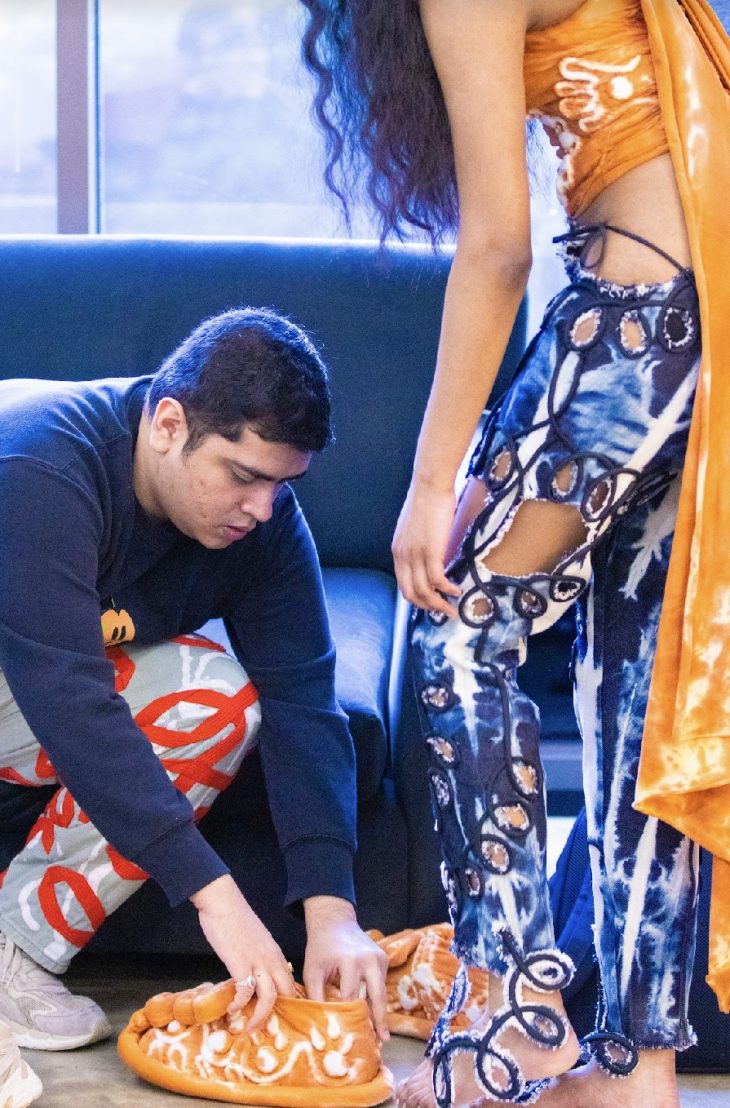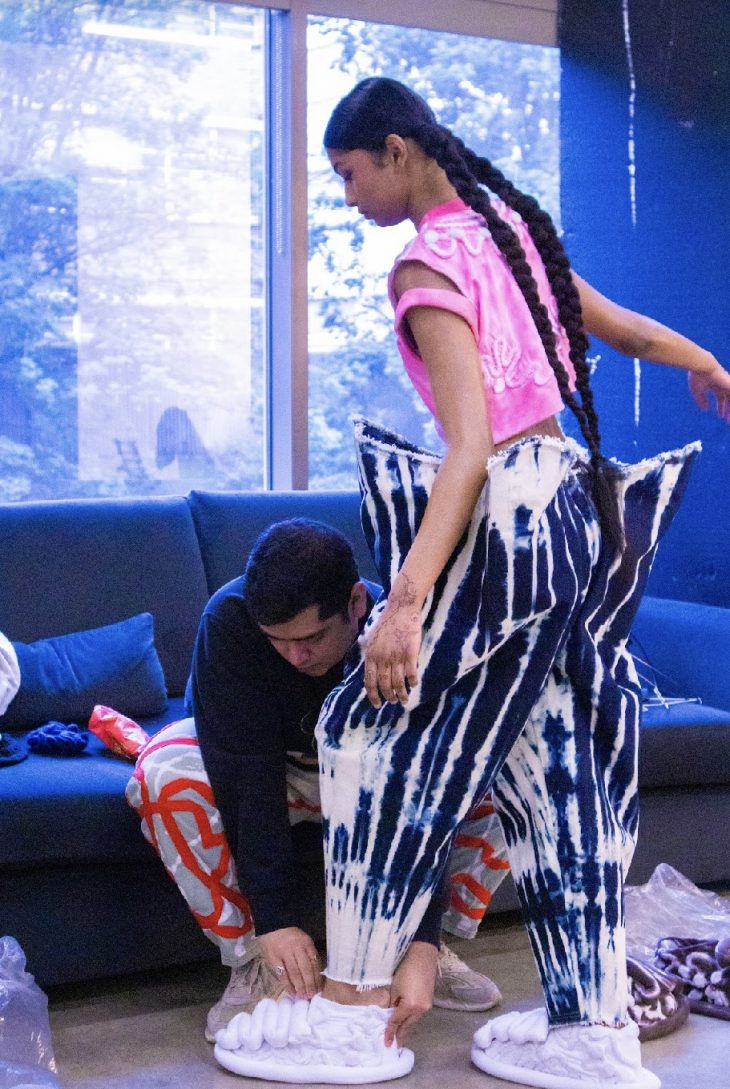#interviews
SOUTH ASIAN HERITAGE MONTH | DHRUV BANDIL
Dhruv Bandil
For South Asian Heritage Month, Models1 teamed up with designer Dhruv Bandil for his new collection, ‘Awakening Kakanmath Kalavatis,’ featured in the August issue of Grazia India.
Dhruv Bandil, from Morena, Madhya Pradesh, India, studied Fashion Design at Central Saint Martins (MA Fashion Womenswear). Bandil’s new collection, ‘Awakening Kakanmath Kalavatis,’ draws inspiration from India’s rich cultural heritage, particularly ancient temple sculptures. Bandil pays homage to the artist Jamini Roy with his bold graphic style embedded in his designs, reinterpreting elements into modern and wearable creations. Bandil focuses on the fusion of tradition with contemporary fashion.
Since winning the L’Oreal Professional Creative Award, Bandil has showcased his work at London Fashion Week and has been published in Vogue India. “Each of Dhruv Bandil’s garments is made with a keen sense of purpose that intimates a dialogue between century-old antiquities and bright textiles that invoke the graphic style of the renowned artist Jamini Roy. In the process, these garments breathe new life into these timeless symbols of femininity, sexuality, and sacred power” (Vogue India, 20th February 2024, Zara Afthab).
In an interview, Bandil expressed how this experience has “boosted my confidence and provided me with incredible opportunities.” Bandil has also revealed that he has been working on a new collection, which he described as an expansion of ‘Awakening Kakanmath Kalavatis.’





QUESTIONS WITH GRAZIA INDIA
How does your creative process begin when conceptualizing a new collection?
The conceptual aspect of a collection often originates from a profound obsession. It’s a deeply moving feeling that becomes inescapable, compelling me to channel and recreate it through the collection. This intense passion drives the creation process, infusing each piece with the essence of that moment.
What role do you believe fashion plays in addressing social issues, such as the plight of the widows in Vrindavan?
Fashion plays a crucial role in addressing social issues by raising awareness and driving change. As a medium of expression, fashion is a way to exist in a particular society. What you put on your body reflects not only you but also your ideology. When people start putting consciousness into what they wear, they can bring suppressed social issues to the forefront. It challenges stereotypes by embracing diversity and providing a platform to express your opinion. In my collection threshold of Vrindavan widows , I was looking at how the will-power off an individual can drive him through difficult time, in this condition the thought of being empowered in their afterlife keeps the widows going until they are united with the absolute in their threshold moment.
What inspired you to start your journey in fashion design?
My first recollection of saying the words “Fashion Designer” rolls back to when I was about five years old. My uncle would ask me about my future plans, and I would tell him that I wanted to be a fashion designer. My cousins used to tease me about my response, but the answer manifested itself over the years.
How has your upbringing in Morena, Madhya Pradesh, influenced your design aesthetic?
Growing up in Morena, Madhya Pradesh, deeply influenced my design aesthetic. The way women drape their sarees, the clothing in local tableaux, the way my mother used to put a black dot beneath her bindi, and the sculptures at ancient archaeological sites in the Indian countryside have all been and continue to be a significant part of my creative consciousness. These recollections, I feel, become building blocks of the alternative reality I create.
Can you describe the significance of your collection, “Threshold of Vrindavan Widows”?
The collection signifies how your thoughts empower yourself. Growing up in Morena, I spent a lot of time with my family in Vrindavan. It is the childhood home of the Hindu Lord Krishna. Widows from all around the country seek refuge here. They have been abandoned by their own family and have come to Vrindavan in search of tranquillity. They await death in order to be united with the Almighty. I aim to convey the moment of their union, the threshold for which they live, in this collection. Their ultimate bliss is death, which liberates them from their earthly body and ushers them into a tidal surge of celestial energy.
How do you use colour theory in your designs, particularly the bold hues seen in your latest collection for the Central Saint Martins MA fashion show?
I’ve come to realize that restricting myself to only a few colours doesn’t quite resonate with me. There’s a vast spectrum of hues to explore and enjoy, which I find essential in my design process. I draw inspiration from various artists, each chosen according to the project’s needs, especially admiring how they skilfully balance colours. Growing up in Morena, I’ve always been surrounded by vibrant shades that naturally influence my work. To achieve this balance, I experiment extensively with different colour combinations. In my experience, working with colours goes beyond digital representations or printouts; it involves physically engaging with materials. The tactile qualities of fabrics and their unique colour properties when touched play a crucial role in my creative process. Additionally, considering how textures interact with chosen colours is equally vital when selecting hues for specific garments.
What are your thoughts on the current state of Indian fashion on the global stage?
Fashion, in general, is transcending boundaries and is no longer confined to a specific demographic. This evolution applies to Indian fashion as well, which is now recognized as fashion on a global scale rather than being strictly labelled as “Indian Fashion.”
How do you maintain a balance between artistic expression and wear ability in your designs?
In my design process, my primary goal is to encapsulate and express a distinct identity that resonates deeply with me. This identity is not merely a concept but a lived reality, something I believe in wholeheartedly. As I push myself creatively and technically, I aim for my designs to transcend mere artistic expression—they should embody practicality and functionality, ensuring that they are not only visually compelling but also accessible and wearable for those who identify with the ethos behind each piece. This commitment to merging artistic vision with real-world utility drives my creative journey, resulting in designs that are both meaningful and purposeful.
Can you discuss a specific piece from your collections that holds particular significance to you?
A standout piece in my latest collection, “Awakening Kakanmath Kalavatis,” is a bodysuit inspired by the dancing girl from the Indus Valley Civilization. The bangles adorning the figurine’s hands are echoed in the garment’s design, creating a striking harmony in the overall look. This piece perfectly balances the past, present, and future, making it particularly captivating to me.
How does the cultural heritage of Indian temple figures inform your design philosophy?
In the rural areas of India, there are numerous archaeological sites where deities reside. Sculptures representing sexuality, divinity, strength, and artistic expression can be found in many temples in my state. These sculptures reflect traditional roles and feminine power, while also subtly highlighting the significance of women. These are the characters I am reimagining as “Art Addicts” for the collection. These individuals never gave up their crayons. They inject themselves with raw, provocative energy and rebel against conventions and norms. With this collection, I’m reimagining how these identities would exist in the present day, while honouring the values they embody.
What are your thoughts on the current trends in sustainable fashion, and how do you see your work contributing to this movement?
When you merge words like trend and sustainability in a single sentence, it can give the impression that sustainability is merely a buzzword of the moment. However, it should be a key focus for our generation, ensuring it becomes the norm for future generations. I’ve had a few pieces that I wear repeatedly, regardless of the wear and tear they endure. The value and uniqueness they hold make me cherish them even more. I believe that if we focus on creating pieces with inherent value, they will naturally be more sustainable, rather than promoting the production of generic clothing.
CREDITS
Designer Dhruv Bandil @dhruvbandil
Hair & Make up Tasnim Nahar @tasnim_makeupartist
Models Kerethika & Ayran @xxkerethika @aryanp2309 @models1
Production Phoebe Lascelles @byphoebel @phoebe.lascelles


